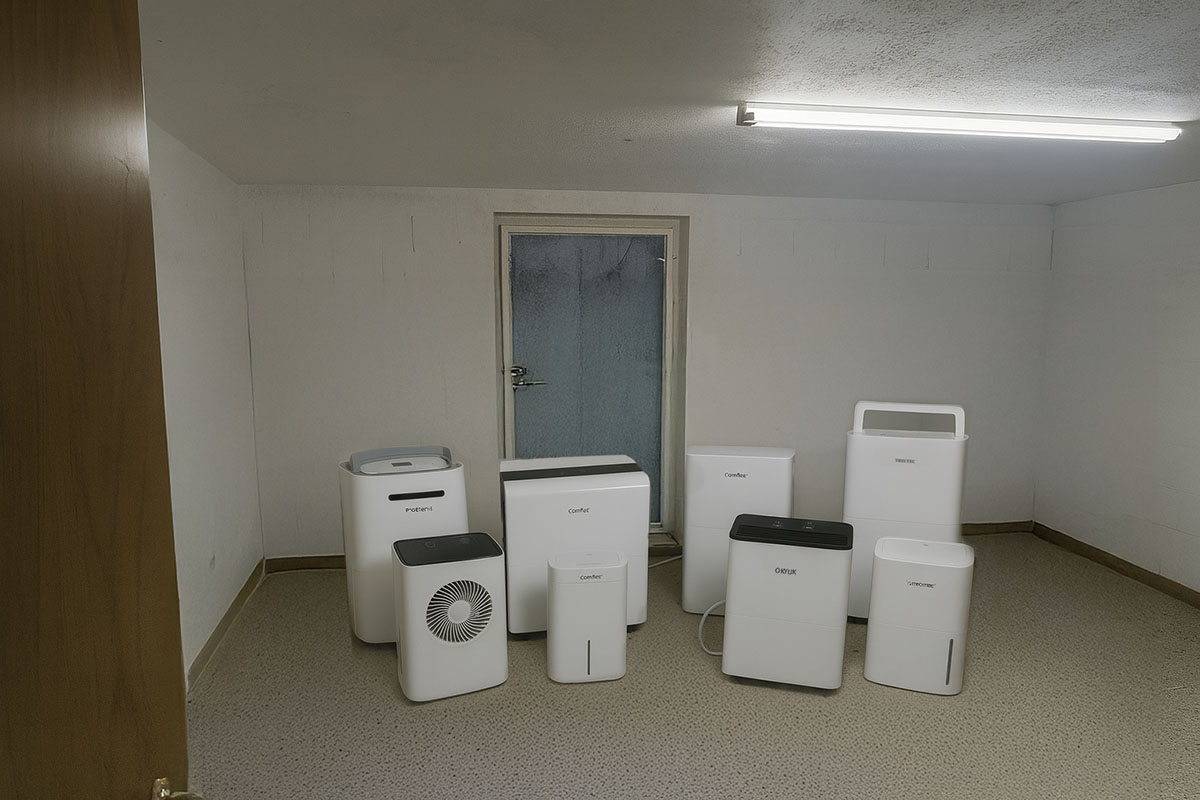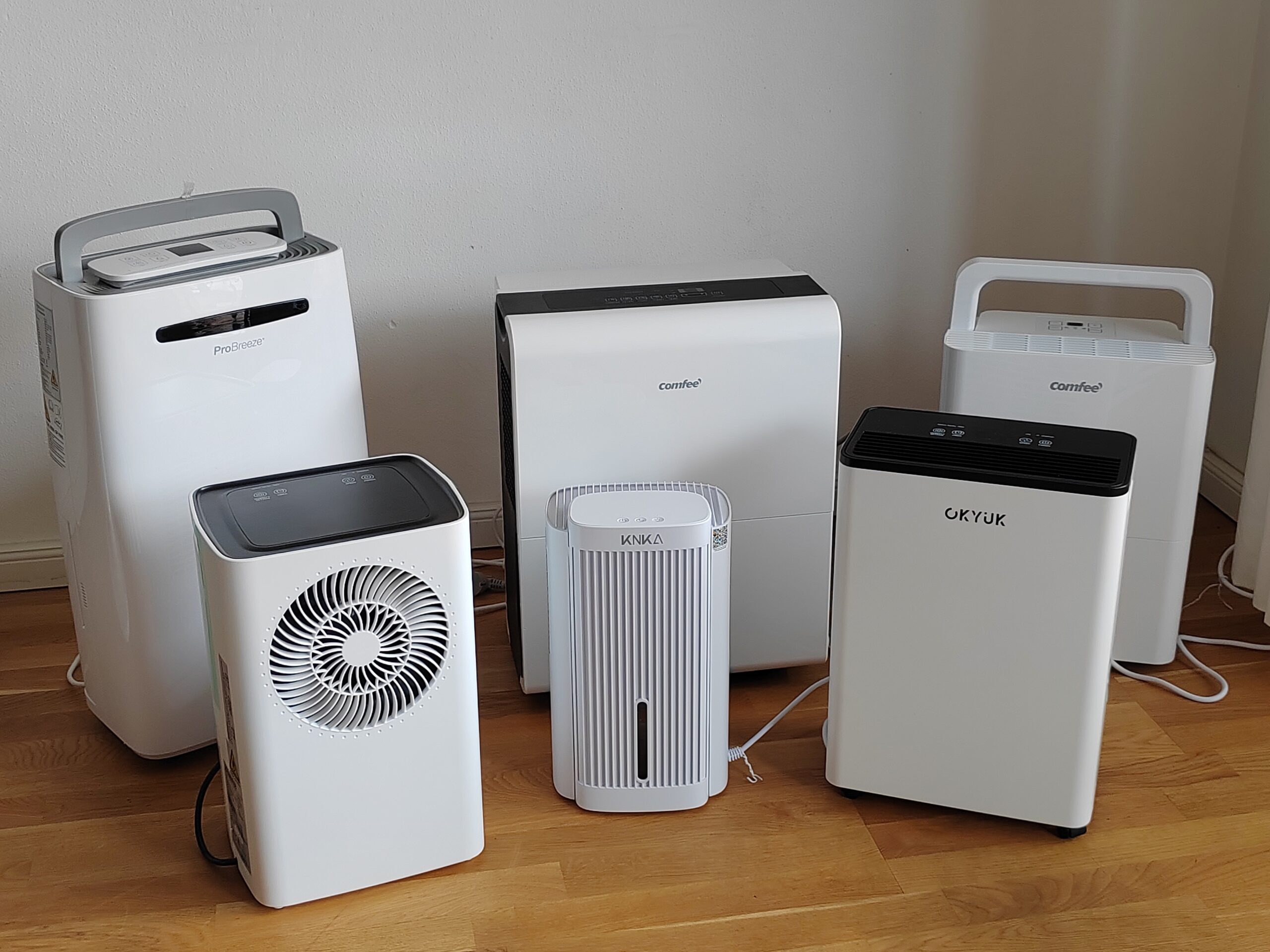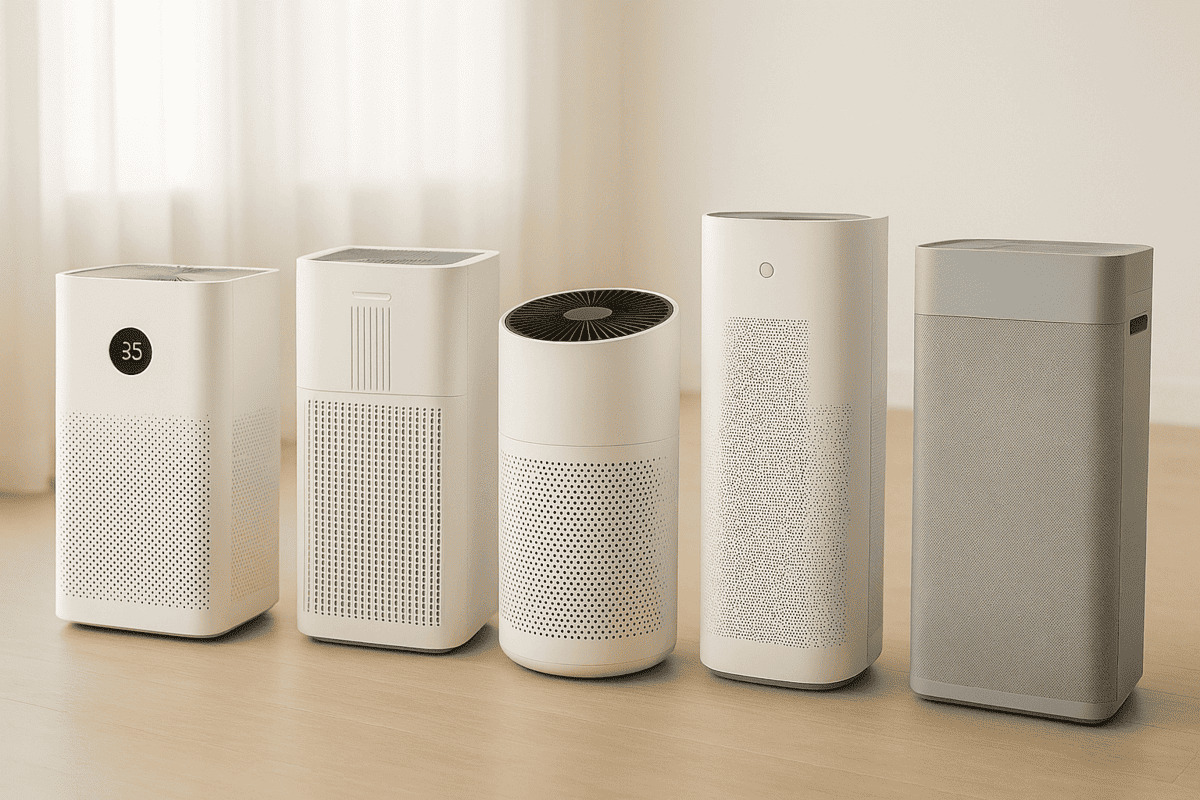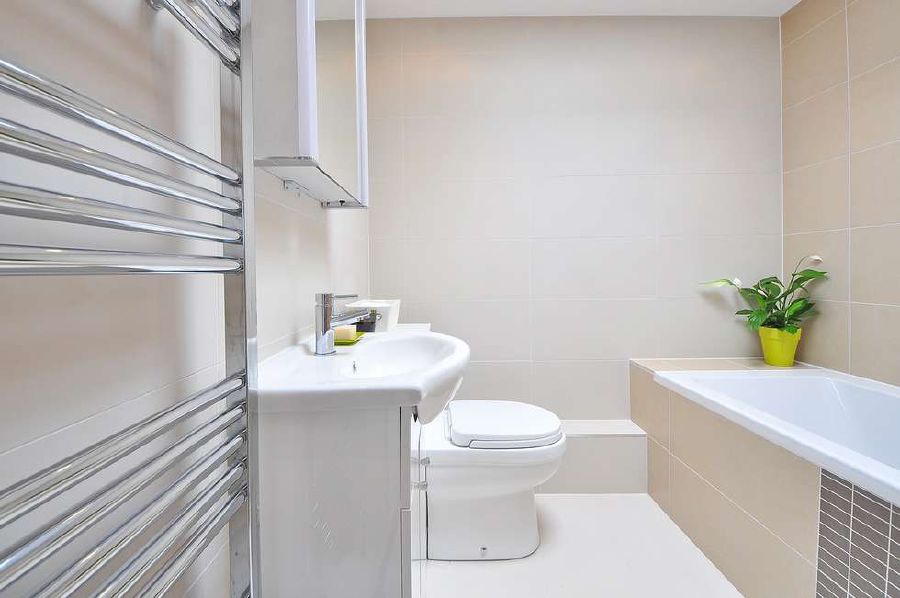Dehumidifier for the basement in the test - real measurements & our test winners 2025
I have tested various dehumidifiers for basements - with my own measurements, pictures and videos. Instead of unrealistic laboratory conditions such as 30 °C and 80 % humidity, I'll show you how the appliances really perform in real cellar rooms with humidity problems and which models were convincing in the test.
Best dehumidifiers for cellar rooms
To my dehumidifier basement test & comparison:
In my test, I mainly used models with 10-30 litres per day - including well-known manufacturers such as Comfee, Pro Breeze, Okyuk, Colaze, Newentor, Meaco, Trotec and Klarstein. The focus was on basements with moisture problems: The decisive factors were Dehumidification performance, Continuous operation, Automatic switch-offs and the best possible Energy-saving operation.
The noise level played a subordinate role, as cellars are generally not permanently inhabited.
Tests were carried out under real conditions - both at warmer 24 °C and at cooler 14 °C. Compact models from 8 l/24 h for smaller cellar rooms and powerful devices with 20-40 l/24 h for large rooms were used. I used the Temtop LKC-1000S+ to precisely measure humidity and air quality. Only a direct comparison reveals the strengths and weaknesses of the individual appliances and which dehumidifier is best suited for which application in the cellar. One of them was clearly the test winner - you can find the details in the following report.
Under my test you will also find general information about humidity in the cellar and tips for the efficient use of dehumidifiers.
Best dehumidifiers compared and tested
It quickly became clear during the test: If you want to noticeably reduce the humidity, you should consider models from around 10 litres/24 hours. Even in small rooms - such as a bathroom with only 4 m² - mini appliances can barely keep up. After all, the actual purpose of a dehumidifier is to reliably reduce humidity and thus Prevent mould growth and create a pleasant indoor climate.
I measured all the appliances myself - volume in dB, temperature, humidity and how much water ends up in the container in a given time. This makes it immediately clear how well the individual models really work in practice - and not just on paper.Comfee dehumidifier - 30L/24h, - The best option for large cellars
Advantages
❌ Disadvantages
Dehumidification performance & use in the cellar
Already in our Dehumidifier test for living rooms and bedrooms the Comfee was convincing - it finished directly behind the OKYUK. In the Dehumidifier cellar test he now secures the Test victorybecause its power is specially optimised for larger and more humid rooms such as cellars.
At 25 °C and around 60 % humidity, it extracts approx. 740 ml of water in one hour - even at a cooler 15 °C and 70 % humidity, it still extracts 695 ml. Values at which smaller 10-20 litre models have long since reached their limits. For damp cellars or large areas, it noticeably improves the room climate after just a short running time.
Size & volume
At almost 18 kg, the Comfee is one of the heavier models - the castors keep it mobile, but compared to compact appliances it is more of a "lump". The noise level is around 50-55 dB and is therefore borderline for living rooms or bedrooms, but unproblematic in the basement.
Operation & functions
The hygrostat display measures precisely and only deviated from the reference device by a few per cent in the test. For comparison: the Pro Breeze 20 l often displayed values around 10 % higher. Operation is simple, with automatic mode, continuous operation, timer and target value control. A drain hose can be used for continuous use in the cellar.
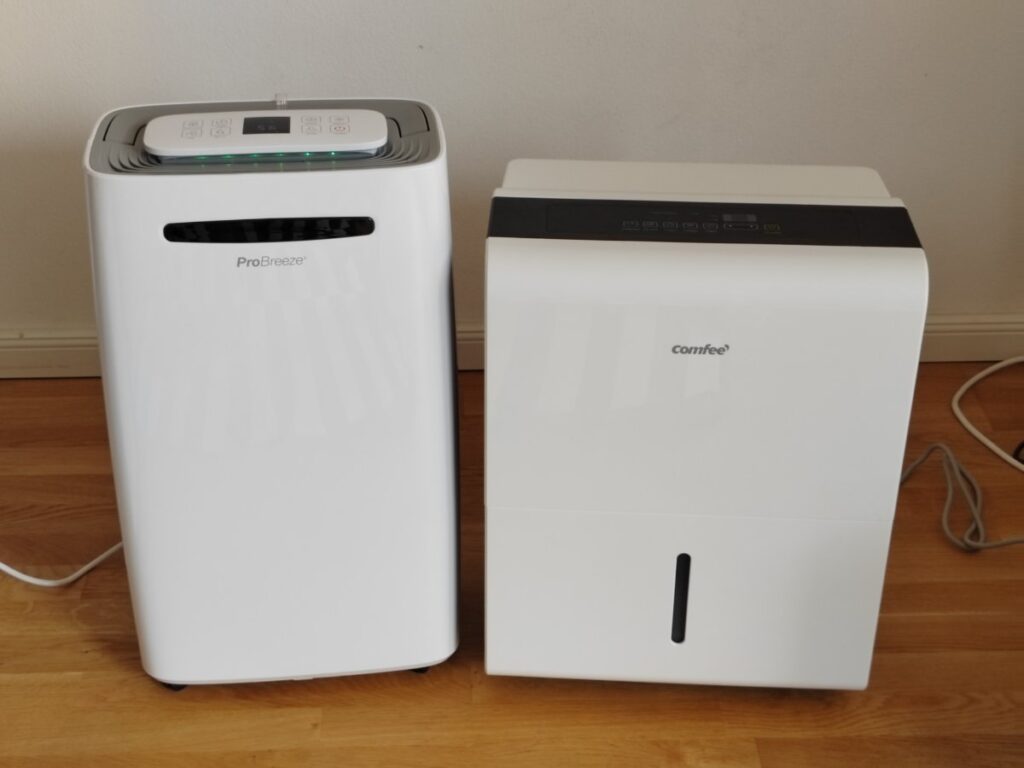
Price-performance ratio
In terms of price, the Comfee is almost on a par with the Pro Breeze 20 l, but offers more power, a more accurate display and better features - clear advantages for larger cellars.
Conclusion
Who Very damp cellars or large rooms reliable dehumidification, the Comfee 30 l is the ideal solution. High-performance powerhouse. It is heavier and louder than compact models, but delivers a Unbeatable dehumidification performance for its price segment. Our clear recommendation for the cellar and continuous operation.
Okyuk dehumidifier - Best dehumidifier 12 litres/24h – test winner
Advantages
❌ Disadvantages
With 25 °C and approx. 60 % humidity the appliance extracts around 210 ml water from the air. Even with 15 °C and 70 % performance remains almost the same - a major advantage over many other models, which drop significantly in cooler temperatures.
In small cellars up to 10 m² the model works excellently and noticeably reduces the humidity. In Larger cellar rooms from about 40 m² however, it reaches its limits, as the dehumidification performance and the 2.5 litre tank are not sufficient for continuous operation.
Size, volume & handling
With only 7.6 kg the dehumidifier is one of the more compact devices and is easy to move thanks to its castors. The volume is 36-41 dB and is therefore extremely quiet - however, this advantage hardly plays a role in the basement, as volume is usually of secondary importance here. For living rooms, on the other hand, it is one of the quietest in the test.
Processing & operation
The device has a high-quality finish and looks much more stylish than the larger Keller models such as the Comfee 30 l/24 h. The humidity display is precise and only deviates from my calibrated Temtop measuring device by approx. ±4 %. There is automatic mode, adjustable target values, continuous operation with hose connection and two power levels.
Comparison of use
- Living rooms / bedrooms: It is my clear favourite here, as it is quiet, compact and reliable.
- Small cellars (up to 10 m²): Well suited for occasional dehumidification after rain or in humid seasons.
- Large cellars (from 40 m²): Here the power and above all the tank volume are not sufficient - for the Continuous operation I recommend more powerful models such as the Comfee 30 l/24 hwhich was the test winner in our cellar test.
Conclusion
For Smaller cellars this dehumidifier is a good choice if you attach importance to Quiet operation and Compact design lays. However, those who Larger cellar rooms dehumidification or a device for the permanent use should go directly to a more powerful model reach.
Pro Breeze 20l/24h - Largest water tank and solid performance
The Pro Breeze dehumidifier with 20 litres per day was in my Cellar test a real positive surprise. What at first glance appears to be a typical, white household dehumidifier turns out to be a real surprise in everyday use. Powerful helper against high humidity, mould and musty cellars.
Compact & flexible use in the cellar
The dehumidifier has a compact design and can be easily Castors and carrying handle can be easily moved to different cellar rooms. With its dimensions of 25 × 39 × 66 cm it also fits well into narrower cellar niches. Particularly practical in the cellar: it can also be Tumble drying and noticeably shorten the drying time.
Operation & functions
The operation is kept simpleSet target value, switch on, done. The LED display reliably displays the current humidity and the hygrostat automatically adjusts it. For the Continuous operation A drain hose can be connected in the cellar - ideal if you don't want to keep emptying the tank. If the Large 5.5 litre tank the appliance switches off automatically as soon as it is full.
Performance in the basement
In the practical test, the Pro Breeze extracts 25 °C and approx. 60 % humidity round 430 ml water per hour. Even with cooler 15 °C and approx. 70 % he still manages about 320 ml per hour - is absolutely sufficient for most cellar sizes. Compared to smaller 10 or 12 litre appliances, it delivers noticeably more power and also keeps larger rooms permanently dry.
Volume
With 50-55 dB the Pro Breeze is as loud as the Comfee 30 l/24 h. This would be annoying in the bedroom, but in the cellar it doesn't matter. no role - where performance and tank size count much more.
Comparison with Comfee & other models
In direct comparison with the Comfee 30 l the Pro Breeze has a little less power, but scores with the largest tank in the test (5.5 litres) and the lower weight of just under 12 kg. It is easier to move, more suitable for everyday use and needs to be emptied less often. Who Maximum dehumidification for very large cellars needs, reaches for the Comfee, who needs a Good balance of performance, mobility and tank capacity is best served by the Pro Breeze.
Conclusion
For Cellar rooms up to medium size the Pro Breeze 20 l is a Very good choiceLarge tank, continuous operation possible, solid performance even in cooler temperatures. The noise level is secondary in the cellar and the appliance can be positioned flexibly thanks to its castors. Who Even more power for very large cellars over 40 m², for example, is found in the Comfee 30 l an even stronger alternative.
Trotec TTK 66 E 24L/24h - Reliable cellar dehumidification with automatic system
Advantages
❌ Disadvantages
The Trotec TTK 66 E had to show what it can do in my cellar: two rooms, one just under 15 m², the other around 40 m² - both cool (10-15 °C) and with high residual humidity after building work.
After just a few hours in the small room, it became apparent: The water tank visibly filled up, and after 24 hours just under 5 litres had been collected - a realistic value for this temperature. In the larger room, it ran for several days, but managed to noticeably reduce the humidity and keep it constantly below 55 %.
I found the Comfort modeEspecially in the cellar, where you are not constantly standing next to it, the Trotec automatically regulates in the range 35-50 % and even adjusts the target value to the temperature. So I didn't have to readjust anything - just put the device down, switch it on and that's it. With the hose connected, I could even leave it running for days without having to empty the tank.
The Operation is pleasantly simple: four modes are all you need, plus a clear display and a memory function for the settings - helpful if you combine it with a timer.
VolumeAbsolutely unproblematic for cellars, okay in the living room, but no real night mode available. On the other hand, it is technically robust: large heat exchanger, tight filter, no unpleasant odours.
The bottom line is that the TTK 66 E delivers a Reliable cellar performanceno frills, but with a focus on the essentials: Extracting moisture - and it does this consistently.
MEACO Ultra Quiet 25L/24h - Efficient basement dehumidifier with smart app and HEPA filter
Advantages
❌ Disadvantages
The MeacoDry Arete Two 25L is in a completely different league compared to other appliances in my cellar test: it combines a dehumidifier and air purifier - and this is immediately noticeable in its features and ease of use.
I tested it in two cellar rooms: a small room (15 m²) and a large area (approx. 40 m²), both with a typically cool climate of around 12-14 °C. After just a few hours of operation, I noticed how quickly it reduced the humidity. On average, the dehumidification performance was around 234 ml per hour - an extrapolation of around 5.6 litres in 24 hours under cellar conditions. While other devices in my tests need several days to get below 40 %, the Meaco manages this in just over half the time.
Particularly practical is the Real night modeThe light and signal tones are then completely deactivated and the fan runs at a very quiet level - perfect if you use it near a sleeping area or living room. In the basement, the volume is less disturbing anyway, but even there it was pleasant because you simply "forget" about it.
Particularly useful in everyday life: the Bar displaywhich clearly displays actual and target values, as well as the App connection. I mainly used the latter to check the status from the upper floor without having to go downstairs - especially handy in winter. The integration with Alexa/Google is more of a bonus, but it works reliably.
Also as Air purifier The HEPA H13 filter also filters dust and mould spores, resulting in noticeably better air in the cellar. After a few days of operation, the air was noticeably less musty.
In the Laundry mode it has plenty of power (up to 57 dB), so it also dries wet clothes quickly - but it is more audible in this mode. In automatic mode, it remains significantly quieter and even switches off completely when the target value is reached.
Conclusion: The MeacoDry Arete Two 25L is a premium appliance - both in terms of price, performance and convenience. For all those who not only dehumidify, but also want to improve the air quality at the same timeit is an excellent solution in the cellar.
Comfee dehumidifier 10L/24h, room size approx. 40m³(16m²)
Advantages
❌ Disadvantages
With a dehumidification capacity of up to 10 litres per day, the appliance is ideal for rooms up to around 16 m² (approx. 40 m³). This is also evident in practice: after just 30 to 45 minutes, a noticeable difference in the air quality was noticeable. I was able to significantly reduce the drying time of my hanging laundry, especially in the bathroom.
Operation is intuitive and simple - ideal if you just want a reliable appliance without a lot of bells and whistles. The LED display can be used to set target humidity values between 35 % and 85 %, as well as a timer and various modes. I personally find the reduced menu navigation very pleasant - less is sometimes more.
I was also pleasantly surprised by the mobility of the appliance: castors and a carrying handle make moving it around child's play. One clever detail is the frost protection mode, which switches on automatically and protects the appliance from damage caused by the cold - this was particularly important in an unheated cellar.
However, there are also some minor drawbacks. The operating noise is clearly audible, especially in very quiet rooms. It's not an unpleasant sound - more of a steady hiss - but I wouldn't leave it running in the bedroom at night. The water tank is also relatively small (2 litres), which means that it fills up quickly when the humidity is high and needs to be emptied more often.
Another detail: although there is an automatic switch-off when the target value is reached or the tank is full, there is no simple timer function for "run for x hours and then switch off". That would have been a practical feature.
Despite these minor criticisms, I am very satisfied with the Comfee dehumidifier. It delivers a strong performance, is solidly built and does exactly what it is supposed to do: reliably dehumidify the room air. If you are looking for a simple, effective appliance for typical living spaces, you definitely can't go wrong with this model.
KLAMER dehumidifier electric 20L - 180m³
Advantages
❌ Disadvantages
A big plus is the high air circulation rate of 180 m³/h, which is also reflected in the rapid effect. Rooms are pleasantly dry again within a short time. I was particularly impressed by how efficiently the dehumidifier works when drying laundry. The humidity drops and the laundry dries faster - without any unpleasantly stuffy room air.
The appliance is conveniently mobile. The four castors and practical handle make it easy to move. Despite its power, the KLAMER is comparatively quiet - ideal for daytime use in the living room. However, it is too loud for the bedroom, as many buyers confirm. It is therefore better to switch it off at night.
Operation is intuitive. I particularly like the three-colour LED display for the current humidity status (blue, green, red). The humidity display is also surprisingly precise - compared with an external hygrometer, the values were only around 5 % apart.
One small point of criticism is the position of the water tank: this is located at the back - including the fill level indicator. This makes it a little awkward to use in small rooms, as you may have to turn the appliance to see the water level or remove the tank. You should also make sure to switch off the appliance a few minutes before emptying it, otherwise water may run out.
All in all, the KLAMER dehumidifier is a real workhorse - reliable, cleverly designed and efficient. The workmanship is high quality and the price-performance ratio is absolutely right. If you can live with the rear tank removal, you will get an all-round successful appliance that does its job excellently.
Newentor 20L dehumidifier Electric basement 39dB
Advantages
❌ Disadvantages
The appliance not only works efficiently, but also extremely quietly. At just 39 dB in operation, it is even suitable for sensitive environments such as the bedroom or living room.
The indoor climate improved noticeably after just a few hours. I noticed a significant reduction, especially in the bathroom, where there is often a lot of moisture. The air in the cellar now also feels much fresher and more pleasant. The dehumidifier keeps the humidity constantly at a low level - ideal for mould prevention.
Operation is extremely simple: the touch display is clearly laid out, shows the current humidity and allows precise control of the target values. The 1.5 metre long drain hose supplied is a real convenience plus - so you don't have to keep emptying the tank. Those who still rely on the tank will find a sufficiently large volume and an automatic switch-off function when the tank is full.
The appliance has a modern, high-quality look. It blends unobtrusively into the room, takes up little space and can be moved quickly if necessary. Thanks to its compact construction and sophisticated design, it is suitable for rooms up to 50 m² or 150 m³.
In addition to the performance, the energy efficiency is definitely a highlight: even with regular use, I have not noticed any noticeable increase in my power consumption. The appliance works reliably, efficiently and without any annoying background noise. An all-round successful overall package.
I would also like to emphasise the 10-year guarantee - a strong sign of confidence from the manufacturer. For me, this is a clear plus point and an expression of quality and durability.
General information on dehumidifiers in basements and air humidity
Humidity is an important value for the indoor climate. It indicates how much water is contained in the air. If there is too much water in the air, this can lead to mould. Too little humidity, on the other hand, can irritate the mucous membranes.
It is always advisable to keep an eye on the humidity level. Corresponding sensors cost no more than an ordinary thermometer.
Multifunctional measuring devices that display humidity and temperature at the same time are recommended. They are priced between €10-20.Relative and absolute humidity
So that no misunderstandings arise in the further course of the article: There is the absolute humidity on the one hand, and the relative on the other hand.
With the absolute is the amount of air (usually in grams)that is contained in a certain amount of air (usually one cubic metre). Assuming that a room contains 5 grams of water in every cubic metres of air. Then the absolute Humidity 5g/m³.
The relative humidity indicates the extent to which the air is saturated with water. That sounds more complicated than it is. Here is the explanation:
Warm air can absorb more water than cold air. If the air is 10°C warm, it can absorb a maximum of approx. 9.5 grams of water per m². If it is 20° warm, it is approx. 17.5 grams [ 1 ] .
If we have a cubic metre of air that is 10°C warm and contains 9.5 grams of water, then the relative humidity is 100%. More water is therefore not possible. If it contains only 5.25 grams of water, the relative humidity is 50%.
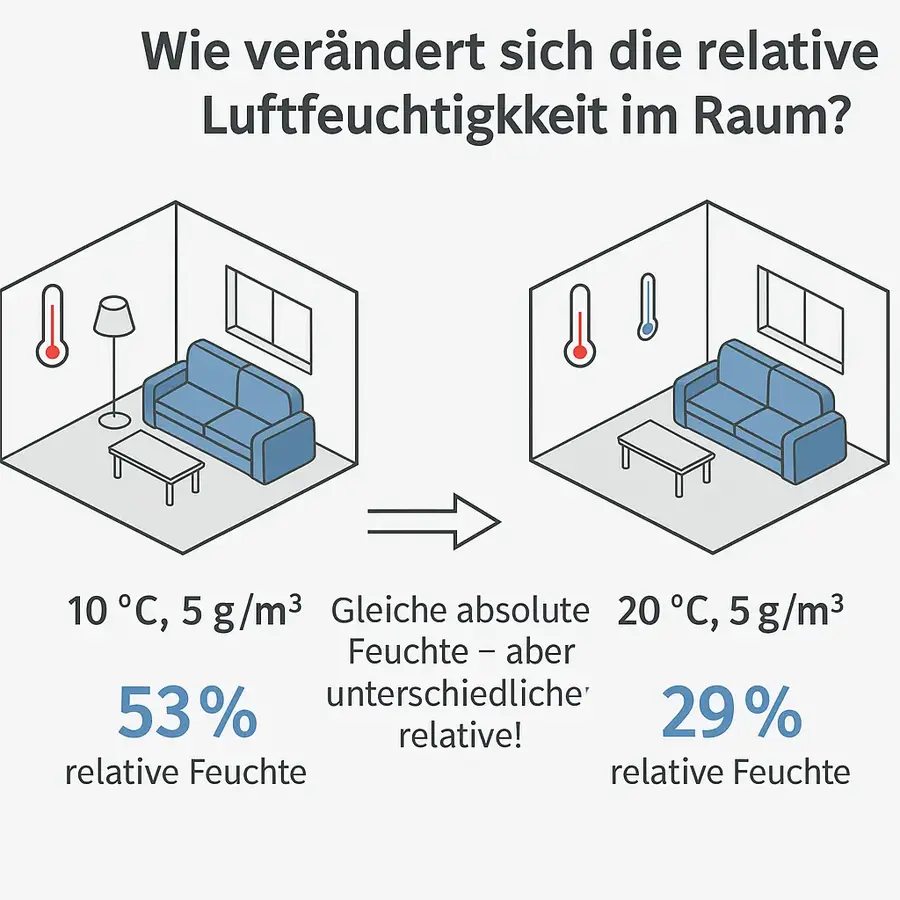
In short: The relative humidity indicates the percentage of water saturation in the air.
Causes of damp in the cellar
Moisture in the cellar can have many causes - often several factors come together at the same time.
A frequent trigger are Structural weak pointsCracks in the walls, leaking joints or poorly sealed floors allow water to penetrate from the outside. Older buildings in particular often lack modern waterproofing, meaning that rainwater or ground moisture can easily find its way into the masonry.
Equally typical is Condensation. Warm, moist air from the living area or from outside meets the cool basement walls and floors, cools down and settles as water. Because cellars are generally less well ventilated and cooler, this happens particularly frequently here - an ideal breeding ground for mould.
Also Groundwater can be a problem, especially in regions with high groundwater levels or after heavy rainfall. The water then presses against the walls from below or from the side, causing permanent damp.
Everyday factors This is exacerbated by the fact that drying damp laundry in the cellar or doing sport there noticeably increases the humidity. Sweat and wet clothing release water into the air - which in turn condenses on the cold surfaces.
To improve the situation sustainably, you first need to know the cause. Then targeted measures can help: Sealing from the outside, better ventilation, regular airing - and a dehumidifier that permanently reduces excess moisture to a healthy level.
Is a dehumidifier an electricity guzzler?
A typical dehumidifier consumes the following during operation between 200 and 700 watts. Depending on the model, room size, humidity and running time, this can lead to lead to significant electricity costs - especially with continuous operation or inefficient use.
What does the power consumption depend on?:
- Power consumption (watts): Higher power = more consumption, but possibly shorter running time
- Running time per day/week: Continuous operation without demand drives up costs
- Setting & target value: The lower the desired humidity, the more the appliance has to do
- Room temperature: Many appliances work less efficiently in cold rooms
- Appliance type & efficiency class: Older models without automatic switch-off or hygrostat consume more
This turns your dehumidifier into an electricity guzzler:
- When he permanently runningalthough the problem could be solved structurally or by ventilation
- When he undersized and never reaches the desired humidity
- When Windows or doors open and new moisture is constantly flowing in
- When Incorrect device types (e.g. condensing units in cold cellars) can be used
How long should a dehumidifier run per day?
This depends on the room size, humidity and appliance output. As a rule 2-6 hours per day if the appliance is strong enough and is used selectively (e.g. after showering, drying laundry or in high humidity above 60 %).
An integrated Hygrostat ensures that the dehumidifier switches off automatically as soon as the target value is reached - thus avoiding unnecessary continuous operation and electricity costs.
Dehumidifier with compressor
Dehumidifiers with compressors also cool the air. Only the method of cooling is different. In principle, the cooling method is comparable to that of a refrigerator. A compressor is also installed in a refrigerator. Sometimes you can even hear it humming.
Let's take a look at how cooling works using a compressor. It will be a little technical, but there is a practical summary at the end. Here we go:

In addition to the compressor, the refrigerant is the key component of the cooling system. Just like water, the refrigerant can be gaseous, solid or liquid.
Water freezes from 0°C, evaporates from 100°C and is liquid in between. The refrigerant, on the other hand, evaporates at room temperature.
When a liquid is vaporised, regardless of whether it is water or a refrigerant, it absorbs heat energy. You also have to place a saucepan of water on a hot hob for the water to evaporate.
Conversely, as soon as the vapour becomes liquid again - i.e. condenses - it releases this energy again. And there we have the whole principle:
If we vaporise the refrigerant at one point, it absorbs heat energy from there. We then channel the refrigerant to another point and allow it to condense there. The absorbed heat energy is then released again.So we have transported the heat from one place to another. The place from which we have taken the heat has become colder. Logical, isn't it?
Vaporising the refrigerant is simple. As I said, it already vaporises at room temperature. After the refrigerant has been channelled to another location, it should condense. But how do we do that? Would we have to cool it again?
This is where the compressor comes into play. It compresses the vapour, i.e. increases the pressure. And if the refrigerant is under high pressure, the temperature at which it condenses drops.
Summary of the mode of operation
The dehumidifier with compressor cools the air, which causes the water vapour from the air to condense on the cold cooling device.
A refrigerant is used for cooling, which absorbs heat energy during evaporation and releases it again during condensation. Consequently, the place where the heat energy is absorbed is cooled.
Advantages and disadvantages
Dehumidifiers that work with a compressor are more efficient than models with a Peltier element. They can extract more moisture from the air. Larger models are used for drying on construction sites, for example, and can remove several litres per hour from the air.
The disadvantage is the volume. The appliance emits a humming noise similar to that of a running refrigerator.
Purchase criteria for dehumidifiers
After we have looked at the functionality and the possible extras, we derive the most important purchase criteria. Here they are in a nutshell:
- Capacity (litres per hour)
- Size of the collection container
- Energy consumption
- Volume
- Additional functions
- Dimensions
- Design
- Price
Performance
How much water the appliance can collect in a certain time is the most important value for me. After all, I don't want it to run all day, but to make progress in as short a time as possible.
Capacity
So that the Container If the container needs to be emptied, it should be large enough. Specifically, it should be able to hold at least 500ml.
Volume
The noise level is particularly important for models that are to be operated in private rooms. A constant humming noise is distracting when working, relaxing - and especially when sleeping. Therefore, check the manufacturer's volume specifications before buying. Recommended values are around 40 dB for living spaces.
It only gets really quiet below 30 dB - which is roughly equivalent to whispering or a quiet bedroom. However, such low values are achieved Only very few devices and mostly only in the Eco or night mode. Those who value maximum peace and quiet should look specifically for ultra-quiet models with Peltier technology or special silent compressors, for example.
Additional functions
About which Additional functions The features of the dehumidifier can be a decisive factor in the purchase decision. As already mentioned, displays showing the current temperature and humidity are practical. A timer or sensor control is even better. With the Timer you can specify how long the device should run. One Sensor control measures the humidity itself and switches the dehumidifier on and off automatically.
Design
The often box-shaped devices are rarely a real feast for the eyes. Therefore, as far as looks are concerned, I recommend as monochrome as possibleinconspicuous housings. White or light grey are ideal here. Flashing displays, convoluted designs or a clunky stand contribute to an unsettling overall impression.
It is better to have a box that is as even as possible, in one colour and can stand flush on the floor and against the wall. If you can also hide unnecessary cable lengths in the appliance, all the better.
Conclusion
Keeping an eye on the indoor climate is always a good thing. If you notice increased humidity, the first thing to do is to Correct ventilation.
But in some rooms this is not always so easy. Be it because there are no windows, No proper draught or simply arises too frequently and too Many moisture peaks (e.g. in the bathroom or kitchen).
To speed up the air exchange, an air filter can be installed in living and working areas. Ceiling fan help. If there are air ducts in the bathroom or kitchen, the typical Bathroom fan can be used to help.
If these options have been exhausted and the desired effect has still not been achieved, a dehumidifier can help. Although it often consumes more energy than fans, it removes moisture effectively.
The opposite of a dehumidifier
If you want to increase the humidity rather than reduce it, there is also a suitable appliance class for this:

Diffuser
Recommended diffusers and how you can use them to improve the indoor climate.
Diffusers vaporise liquid and thus increase the humidity. They can also be filled with fragrances and essential oils, which they then distribute over several hours.
Sources
[1] ↑ https://de.wikipedia.org/wiki/Luftfeuchtigkeit
